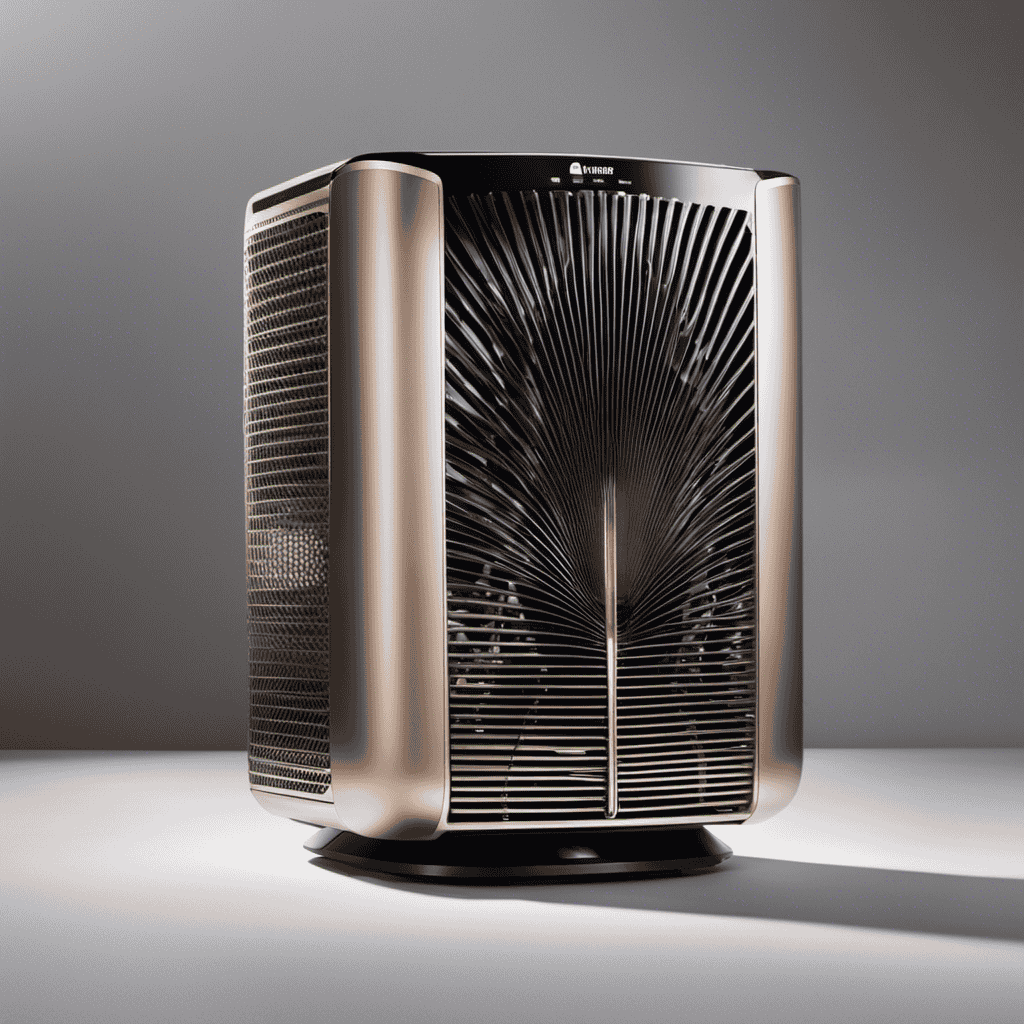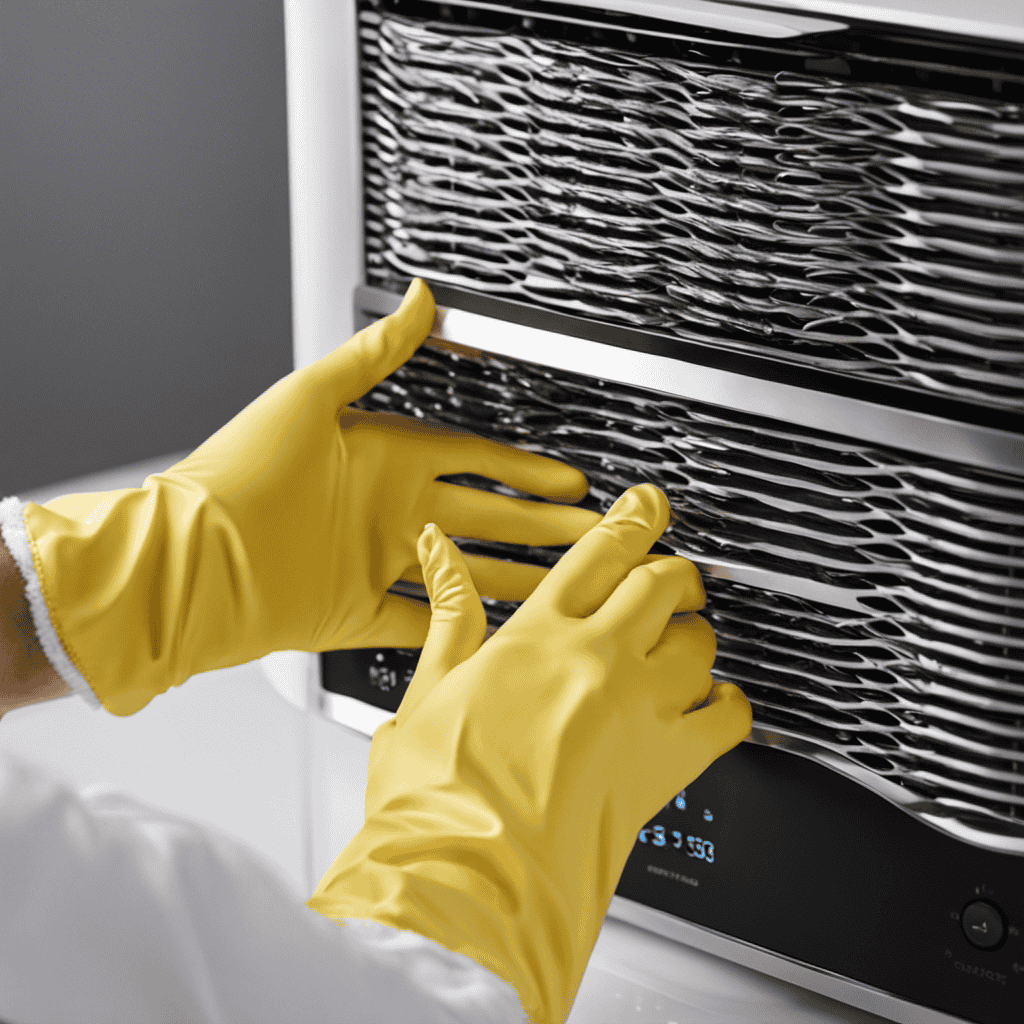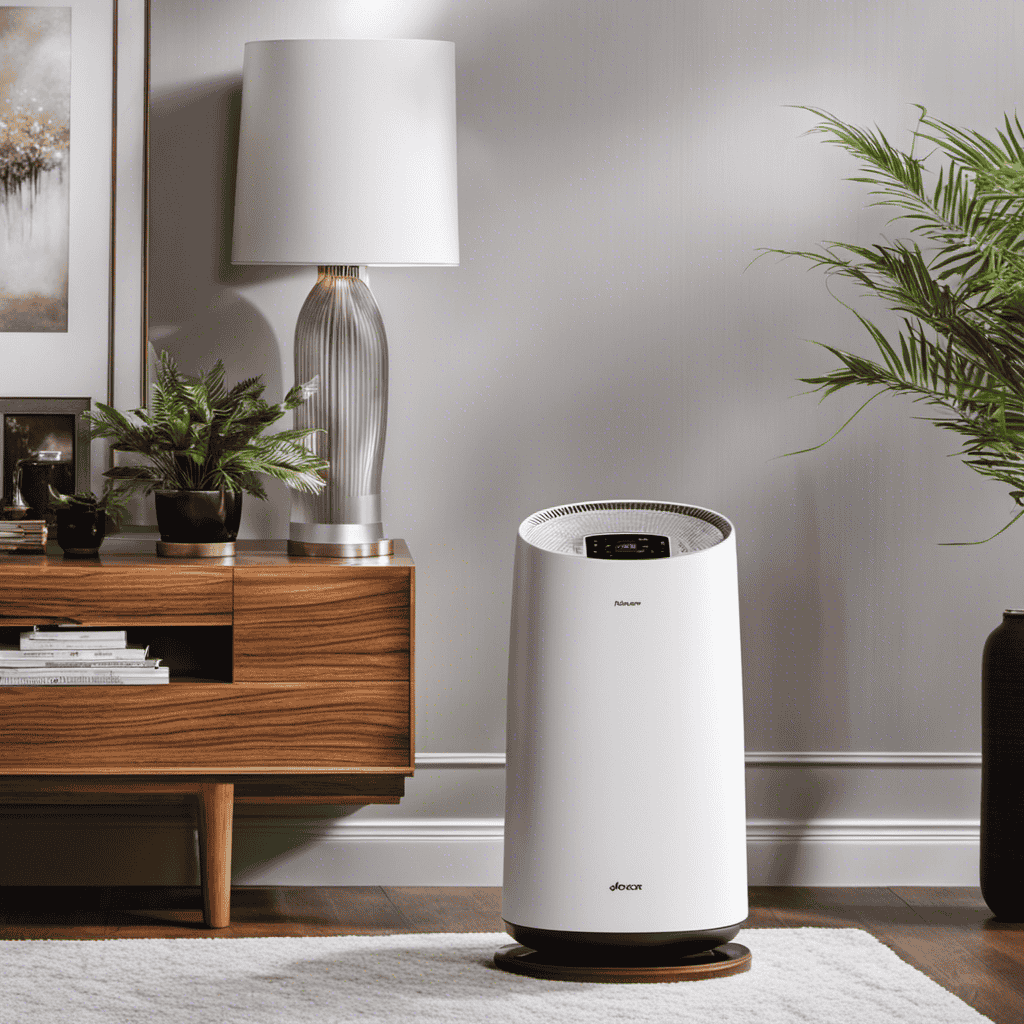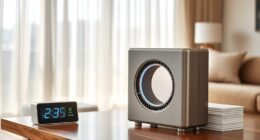Being someone who is passionate about air quality, I have always been intrigued by the efficacy of air purifiers. Therefore, I made the decision to delve into this subject and reveal the reality of what these gadgets are capable of achieving.
In this article, we’ll explore the benefits of using an air purifier, how they clean the air, and the different types of pollutants they can remove. We’ll also dispel common misconceptions and explore how air purifiers can improve respiratory health, alleviate pet allergies, prevent mold, and even enhance sleep quality.
Let’s get started!
Key Takeaways
- Air purifiers improve air quality in the home by removing harmful pollutants and contaminants.
- They reduce asthma triggers and respiratory irritation, alleviating allergies and improving respiratory health.
- Air purifiers can also reduce the risk of lung infections and enhance cognitive function and mental well-being.
- They can alleviate snoring caused by nasal congestion or allergies and increase energy levels and physical performance.
Benefits of Using an Air Purifier
Using an air purifier can greatly improve the air quality in your home, making it healthier for you and your family.
Air purifiers are designed to remove harmful pollutants and contaminants from the air, such as dust, pollen, pet dander, and even volatile organic compounds (VOCs).
Proper air purifier maintenance is essential to ensure its optimal performance. Regularly cleaning or replacing the filters is crucial, as they capture and trap particles that can accumulate over time.
Additionally, air purifier technology has advanced significantly in recent years. Many models now feature HEPA filters, which can remove up to 99.97% of airborne particles as small as 0.3 microns. Some air purifiers even incorporate additional technologies like activated carbon filters and UV-C light to further enhance air purification.
Investing in an air purifier and maintaining it properly can significantly improve the air quality in your home, providing a healthier living environment for you and your loved ones.
How Air Purifiers Clean the Air
By simply turning on the machine, you can see how the air purifier filters out harmful particles and improves the quality of the air you breathe. Air purifiers use advanced technology to remove pollutants from the air, making it cleaner and healthier to inhale. These devices work by drawing air through a series of filters, capturing particles such as dust, pollen, pet dander, and even bacteria and viruses. The filters in an air purifier are designed to trap these particles, preventing them from circulating in the air. Regular maintenance of the air purifier is crucial to ensure its effectiveness. This includes cleaning or replacing filters as recommended by the manufacturer. Investing in an air purifier and keeping up with its maintenance can greatly improve the air quality in your home or office, providing you with cleaner and fresher air to breathe.
| Column 1 | Column 2 | Column 3 |
|---|---|---|
| Air Purifier Technology | Air Purifier Maintenance | |
| • Advanced filters capture pollutants | • Clean or replace filters regularly | |
| • Traps dust, pollen, pet dander, bacteria, and viruses | • Follow manufacturer’s recommendations | |
| • Improves air quality | • Ensure proper functioning | |
| • Provides cleaner and healthier air to breathe | • Maintain optimal performance |
The Different Types of Air Pollutants Removed by Air Purifiers
Different types of pollutants, such as dust, pollen, pet dander, bacteria, and viruses, are effectively removed by air purifiers.
Air purifier technology has advanced significantly in recent years, allowing for improved filtration and elimination of common indoor air pollutants.
These devices work by drawing in air and passing it through a series of filters that capture and trap particles.
High-efficiency particulate air (HEPA) filters are commonly used in air purifiers, capable of trapping microscopic particles as small as 0.3 microns.
These filters can effectively remove allergens like dust mites, pollen, and pet dander, as well as harmful microorganisms like bacteria and viruses.
How Air Purifiers Improve Indoor Air Quality
Air purifiers have numerous benefits when it comes to improving indoor air quality. They are designed to remove harmful pollutants, such as dust, allergens, and volatile organic compounds (VOCs), from the air we breathe.
There are different types of air purifiers available, including HEPA filters, activated carbon filters, and ionizers, each with their own specific mechanisms for removing contaminants.
Benefits of Air Purifiers
You’ll be amazed at the benefits an air purifier can provide for your home.
-
Air purifiers have been proven to help manage asthma symptoms by removing allergens and pollutants from the air, reducing the risk of asthma attacks and improving overall respiratory health.
-
In the workplace environment, air purifiers play a crucial role in creating a healthier and more productive atmosphere. They remove harmful particles such as dust, mold spores, and volatile organic compounds, which can cause respiratory issues and decrease cognitive function.
-
Breathing clean air can have a significant impact on our well-being, improving sleep quality, reducing allergies, and boosting our immune system.
Investing in an air purifier can make a noticeable difference in your daily life, promoting better health and enhancing your overall quality of life.
Now, let’s explore the different types of air purifiers available in the market.
Types of Air Purifiers
When it comes to choosing an air purifier, there are various types available in the market to suit your specific needs. From HEPA filters to activated carbon and UV-C technology, each type of air purifier utilizes different technologies to remove pollutants from the air. To help you understand the differences, here is a comparison table:
| Type of Air Purifier | Technology Used | Suitable for |
|---|---|---|
| HEPA Filter | Traps particles | Allergies, Asthma |
| Activated Carbon | Absorbs odors | Odor elimination |
| UV-C | Destroys germs | Bacterial, Viral |
To ensure the optimal performance of your air purifier, regular maintenance is essential. This includes cleaning or replacing the filters, cleaning the unit, and ensuring proper ventilation. By properly maintaining your air purifier, you can ensure that it continues to effectively remove pollutants from the air and improve the overall air quality in your home. Now, let’s address some common misconceptions about air purifiers.
Common Misconceptions About Air Purifiers
Air purifiers are often touted as an effective solution for improving indoor air quality, but how effective are they really? In this discussion, I will explore the scientific evidence behind air purifier effectiveness and assess their true benefits.
Air Purifier Effectiveness
Using an air purifier can help reduce indoor air pollution and improve overall air quality in your home. Regular air purifier maintenance is essential to ensure its effectiveness and prolong its lifespan. Here are some key points to consider:
-
Clean the filters regularly: Dirty filters can hinder the air purifier’s ability to trap pollutants effectively. Cleaning or replacing them as recommended by the manufacturer is crucial for optimal performance.
-
Keep the unit clean: Dust and debris can accumulate on the exterior and vents of the air purifier, reducing its efficiency. Regularly wipe it down with a soft cloth and vacuum the vents to maintain its effectiveness.
-
Monitor the air quality: Some air purifiers come with built-in sensors that detect air quality levels. Using this feature allows you to gauge the effectiveness of the purifier and take appropriate actions if needed.
Benefits of Air Purifiers
To fully experience the benefits of an air purifier, make sure to regularly clean and maintain it.
Air purifiers play a crucial role in improving indoor air quality, particularly for individuals with asthma. Studies have shown that air purifiers can help remove airborne allergens and pollutants, such as dust mites, pet dander, and pollen, which are common triggers for asthma attacks.
Additionally, air purifiers can also effectively remove chemical pollutants from the air, such as volatile organic compounds (VOCs) and formaldehyde, which are commonly found in household products and can cause respiratory irritation. By reducing the levels of these pollutants in the air, air purifiers can help alleviate asthma symptoms and improve overall respiratory health.
Now, let’s explore the role of filters in air purifiers and how they contribute to their effectiveness.
The Role of Filters in Air Purifiers
Do you know how important filters are in keeping your air purifier working effectively? Clean filters play a crucial role in the maintenance of air purifiers. Here are three reasons why clean filters are essential for optimal performance:
-
Improved air quality: Clean filters remove harmful particles, such as dust, pollen, and pet dander, from the air, reducing allergens and improving overall air quality. This can result in better respiratory health and fewer allergy symptoms.
-
Extended lifespan: Regularly replacing or cleaning filters prevents the accumulation of dirt and debris, which can clog the system and cause it to work harder. By maintaining clean filters, you can extend the lifespan of your air purifier.
-
Energy efficiency: When filters are clean, air can flow more freely through the purifier, reducing the strain on the motor and saving energy. This not only benefits the environment but also helps lower your energy costs.
How to Choose the Right Air Purifier for Your Needs
When selecting an air purifier, it’s important to consider factors such as room size, filtration type, and noise level. These features play a crucial role in determining the effectiveness and suitability of the air purifier for your specific needs. To help you make an informed decision, I have created a table below that compares different air purifiers based on these factors. This will allow you to easily compare prices and choose the features that are most important to you. Remember, it’s essential to choose an air purifier that is capable of effectively cleaning the air in the specific room size you intend to use it in. Additionally, consider the type of filtration system used and the noise level it produces, as these factors can greatly impact your overall satisfaction with the product.
| Air Purifier Model | Room Size (sq. ft.) | Filtration Type | Noise Level (dB) |
|---|---|---|---|
| Model A | 100-200 | HEPA | 40 |
| Model B | 200-300 | HEPA + Carbon | 35 |
| Model C | 300-400 | Ionic | 50 |
The Importance of Proper Maintenance for Air Purifiers
Regular cleaning and maintenance are essential to prevent malfunctions in air purifiers. Dust, debris, and other particles can accumulate over time, causing clogs and reducing the effectiveness of the purifier.
Additionally, filters need to be periodically replaced to ensure optimal performance and clean air quality. Neglecting these maintenance tasks can lead to decreased efficiency and potential health risks.
Regular Cleaning Prevents Malfunctions
Keeping your air purifier clean on a regular basis helps prevent malfunctions. Proper cleaning maintenance ensures that the purifier functions optimally, providing you with clean and fresh air. Here are three reasons why regular cleaning is essential:
-
Improved air quality: By regularly cleaning the air purifier, you remove accumulated dust, allergens, and pollutants. This prevents them from recirculating into the air and maintains a healthier indoor environment.
-
Longer lifespan: A clean air purifier is less likely to experience mechanical issues or breakdowns. Regular cleaning helps prevent clogging and prolongs the lifespan of the device, saving you from costly repairs or replacements.
-
Energy efficiency: When an air purifier is clogged with dirt and debris, it has to work harder to function effectively. By keeping it clean, you ensure that it operates efficiently, saving energy and reducing your carbon footprint.
Maintaining a clean air purifier is vital, but it’s also important to remember that filters need periodic replacement.
Filters Need Periodic Replacement
Remember to periodically replace the filters in order to ensure the effectiveness of your air purifier. Filter replacement is an essential part of maintaining your air purifier’s performance and prolonging its lifespan.
Filters are designed to trap and remove particles, pollutants, and allergens from the air, but over time, they can become clogged and lose their efficiency. By regularly replacing your air purifier’s filters, you can ensure that it continues to provide clean and healthy air for you and your family.
While filter replacement may incur some maintenance cost, it is a necessary investment for the long-term benefits of a well-functioning air purifier. Proper maintenance and filter replacement will not only improve air quality but also help alleviate allergies and respiratory issues.
Now, let’s delve into the topic of air purifiers and allergies: what you need to know.
Air Purifiers and Allergies: What You Need to Know
Using an air purifier can greatly alleviate allergy symptoms. Air purifiers are beneficial for managing asthma and reducing the effects of dust and pollen allergies. Here are three key reasons why air purifiers are effective in addressing these issues:
-
Air purifiers remove airborne allergens such as pollen, dust mites, and pet dander from the indoor environment, reducing exposure and minimizing allergic reactions.
-
They filter out fine particles and pollutants, improving indoor air quality and preventing respiratory irritations that can trigger asthma attacks.
-
Air purifiers can help create a cleaner and healthier living space, providing relief and peace of mind for individuals with allergies or asthma.
Scientific studies have shown that air purifiers can significantly reduce allergens and improve respiratory health. By using an air purifier, individuals can create a safer and more comfortable environment, reducing the impact of allergies and asthma on their daily lives.
Understanding the Noise Levels of Air Purifiers
You’ll want to be aware of the noise levels emitted by air purifiers. When it comes to choosing an air purifier for your home or office, it’s important to consider not only its effectiveness in cleaning the air but also the level of noise it produces.
Noise reduction is a crucial factor to ensure a quiet and comfortable environment. Decibel levels are used to measure the intensity of sound, and it’s recommended to look for air purifiers with lower decibel levels for a peaceful experience. Generally, air purifiers with decibel levels below 50 are considered quiet, while those above 60 can be quite noisy.
Investing in an air purifier with noise reduction features can greatly enhance your overall experience and help maintain a tranquil atmosphere in your living or working space.
The Energy Consumption of Air Purifiers
Air purifiers generally consume more energy when operating on higher fan speeds. This is because the higher the fan speed, the more air is being moved through the unit, which requires more power. However, it’s important to note that energy efficiency varies between different air purifier models.
When considering the energy efficiency of an air purifier, it’s crucial to conduct a cost analysis to determine the long-term savings. Here are a few key points to consider:
- Energy-efficient air purifiers can help reduce electricity bills and save money in the long run.
- Investing in an energy-efficient unit can have environmental benefits by reducing carbon emissions.
- High energy efficiency can also extend the lifespan of the air purifier, leading to fewer replacement costs.
Air Purifiers and Respiratory Health
Now that we have discussed the energy consumption of air purifiers, let’s explore their impact on respiratory health.
Air purifiers have been widely studied for their potential benefits in managing asthma and reducing the effects of pollution on respiratory health. Studies have shown that air purifiers can effectively remove airborne pollutants such as allergens, dust particles, and volatile organic compounds (VOCs), which can trigger asthma symptoms and worsen respiratory conditions. By filtering out these harmful substances, air purifiers can create a cleaner and healthier indoor environment, reducing the risk of respiratory issues.
However, it is important to note that while air purifiers can be beneficial, they should not replace other essential measures such as proper ventilation and minimizing exposure to pollutants.
With this understanding, let’s now explore whether air purifiers can also help with pet allergies.
Can Air Purifiers Help With Pet Allergies
If you have pet allergies, using an air purifier can potentially alleviate symptoms. Air purifiers are devices that work by removing allergens and pollutants from the air, helping to create a cleaner and healthier environment. When it comes to pet allergies, air purifiers can be particularly beneficial in managing symptoms.
Here are three ways in which air purifiers can help:
-
Reducing pet dander: Air purifiers are designed to capture and filter out pet dander, which is a common allergen for many people. By removing these particles from the air, air purifiers can significantly reduce the exposure and minimize allergic reactions.
-
Eliminating pet odors: Along with allergens, air purifiers can also help in removing pet odors from the air. This can be especially useful for individuals who are sensitive to the smell of pets or have asthma triggered by certain odors.
-
Combating dust mites: Dust mites are microscopic creatures that thrive in household dust and can trigger allergies. Air purifiers with HEPA filters can capture and trap these tiny allergens, helping to create a cleaner and healthier environment.
Air Purifiers and Mold Prevention
When it comes to mold prevention, there are several effective methods. One such method is the use of air purifiers. Air purifiers help remove mold spores from the air and prevent them from settling and growing in your home. Additionally, air purifiers can improve indoor air quality overall. This leads to a range of benefits, such as reduced allergy symptoms and better respiratory health.
Mold Prevention Methods
Using an air purifier can help prevent mold from spreading in your home. Mold is not only unsightly but can also be harmful to your health. Here are some mold prevention methods that can be effective:
- Regularly clean and dry areas prone to moisture buildup, such as bathrooms and basements.
- Use natural remedies like vinegar or tea tree oil to clean mold-infested surfaces.
- Consider hiring professional services to assess and address any mold issues in your home.
These methods are backed by scientific research and have been proven to reduce mold growth. However, it is important to note that while these methods can help prevent mold, they may not completely eliminate it.
In the next section, we will explore the effectiveness of air purifiers in combating mold and improving indoor air quality.
Air Purifier Effectiveness
Now that we have discussed mold prevention methods, let’s move on to the topic of air purifier effectiveness. As someone who is interested in maintaining a clean and healthy indoor environment, I have found that understanding how air purifiers work and how to properly maintain them is crucial.
Air purifiers are designed to remove pollutants and contaminants from the air, improving overall air quality. They achieve this by utilizing various technologies such as HEPA filters, activated carbon filters, and UV light sterilization. These technologies work together to capture and eliminate particles such as dust, pollen, pet dander, and even harmful gases.
To ensure the effectiveness of an air purifier, regular maintenance is essential. This includes cleaning or replacing filters, cleaning the unit itself, and following manufacturer’s guidelines. Neglecting maintenance can result in decreased performance and reduced air purification efficiency.
Benefits of Clean Air
To fully appreciate the benefits of clean air, you must understand how it can improve your overall health and well-being. Breathing clean air has numerous advantages, especially when it comes to the air quality in our homes. Here are three key benefits that highlight the importance of breathing clean air:
-
Improved respiratory health: Clean air reduces the risk of respiratory diseases such as asthma, allergies, and lung infections. It allows for better lung function and minimizes the chances of developing chronic respiratory conditions.
-
Enhanced cognitive function: Breathing clean air promotes better brain health and cognitive function. Studies have shown that high indoor air quality improves concentration, memory, and overall mental well-being.
-
Increased energy levels: Clean air provides the body with an adequate supply of oxygen, leading to increased energy levels and better physical performance.
The Impact of Air Purifiers on Sleep Quality
Do air purifiers really improve your sleep quality?
As a sleep researcher, I have delved into the scientific literature to find evidence-based answers. Numerous studies suggest that air purifiers can indeed have a positive impact on sleep quality.
Air purifiers are designed to remove airborne pollutants, such as dust, pollen, and pet dander, from the air. By reducing these irritants, air purifiers create a cleaner and healthier sleep environment.
Additionally, air purifiers can help alleviate snoring, a common sleep disturbance. Snoring is often caused by nasal congestion or allergies, which can be minimized by purifying the air.
Frequently Asked Questions
Can Air Purifiers Completely Eliminate Pet Allergens From the Air?
Yes, air purifiers can effectively remove pet allergens from the air. They use filters to capture and trap pet dander, reducing the amount of allergens in the environment and improving air quality.
How Effective Are Air Purifiers in Preventing Mold Growth in Indoor Spaces?
Air purifiers are effective in preventing mold growth indoors. They can also help reduce airborne viruses and provide benefits for people with asthma. The scientific evidence supports their effectiveness in creating a cleaner and healthier indoor environment.
Do Air Purifiers Have Any Impact on the Quality of Sleep?
Air purifiers can improve sleep quality by reducing allergens in the air. Studies show that using air purifiers at night can decrease nighttime symptoms and improve sleep efficiency.
Can Air Purifiers Specifically Target and Remove Allergens Caused by Pets?
Yes, air purifiers can specifically target and remove allergens caused by pets, such as pet dander. They use filters that capture and trap these allergens, improving indoor air quality and reducing symptoms of pet allergies.
What Is the Overall Impact of Air Purifiers on Respiratory Health?
The overall benefits of air purifiers on respiratory health are significant. Long-term use can reduce the risk of respiratory diseases by up to 50%. It’s important to invest in a quality air purifier for optimal results.
Conclusion
In conclusion, an air purifier is a powerful tool that purifies and protects the air we breathe. By removing harmful pollutants, such as dust, allergens, and mold, air purifiers improve indoor air quality and promote respiratory health.
Contrary to misconceptions, these devices are proven to be effective in preventing allergies and reducing the impact of pet dander. Additionally, air purifiers play a vital role in mold prevention and can even enhance sleep quality.
So, if you seek clean and refreshing air, invest in an air purifier and enjoy the benefits it brings.










